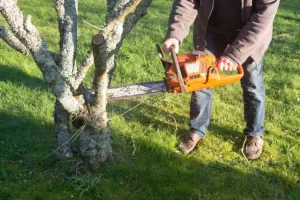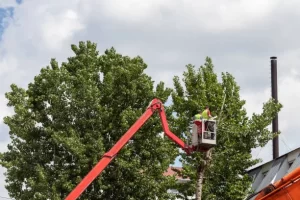Cutting down a big tree is a complex and potentially dangerous task that requires proper planning, the right tools, and a clear understanding of the process. Whether you’re dealing with a dead tree or simply making room for new landscaping, knowing how to safely and effectively cut down a big tree is crucial.
1. Assess the Tree and Its Surroundings
Before you start cutting, it’s essential to evaluate the tree and its environment to ensure safety.
- Identify Hazards: Look for power lines, buildings, and other structures that could be damaged. Assess the tree for any signs of disease or decay that might affect how it falls.
- Determine the Fall Path: Plan the direction in which you want the tree to fall. Ensure there’s enough space and that the fall path is clear of obstacles.
2. Gather the Necessary Tools
Having the right tools is critical for safely cutting down a big tree.
- Chainsaw: Ensure it’s sharp and properly maintained.
- Safety Gear: Helmets, gloves, safety glasses, ear protection, and chainsaw chaps.
- Felling Wedges: These help prevent the tree from pinching your saw and guide the tree in the right direction.
- Ropes and Harnesses: Useful for stabilizing and controlling the tree’s fall.
3. Plan the Notch Cut
The notch cut is crucial for controlling the direction of the tree’s fall.
- Make the Face Cut: Start with a horizontal cut about one-third of the way through the tree on the side facing the direction you want it to fall.
- Create the Top Cut: Angle the top cut downward at about a 45-degree angle until it meets the end of the horizontal cut, forming a notch.

4. Execute the Back Cut
The back cut is what actually causes the tree to fall.
- Positioning: Make the back cut on the opposite side of the notch, about two inches above the bottom of the notch.
- Cut Carefully: Cut slowly, inserting felling wedges as needed to prevent the tree from leaning back and pinching the saw.
- Watch for Movement: As the tree begins to fall, remove the chainsaw and move to a safe distance quickly.
For expert assistance in tree felling, visit our Tree Removal Services.
5. Controlling the Fall
Proper control of the tree’s fall is essential to ensure safety and prevent damage.
- Use Ropes if Necessary: For larger trees, ropes can help guide the tree’s fall more precisely.
- Stay Clear: Never stand directly behind the tree or in the path where it’s expected to fall.
- Plan Escape Routes: Have at least two escape routes planned and cleared before starting the back cut.
6. Limbing and Bucking the Tree
Once the tree is on the ground, the next steps are to remove the branches (limbing) and cut the trunk into sections (bucking).
- Limbing: Start from the base and work your way up, cutting branches flush with the trunk.
- Bucking: Cut the trunk into manageable sections, being mindful of tension and compression in the wood to prevent the saw from binding.

7. Cleaning Up
Proper cleanup is essential after cutting down a tree.
- Remove Debris: Collect branches, leaves, and other debris.
- Stump Removal: Decide whether to grind or remove the stump based on your landscaping plans.
- Dispose of Wood: Consider using the wood for firewood, mulch, or disposal.
Consulting a Professional
Cutting down a big tree is not a task to be taken lightly. Consulting a professional arborist can ensure the job is done safely and effectively.
- Safety: Professionals have the expertise and equipment to handle large trees safely.
- Efficiency: They can complete the job faster and more efficiently than most DIY efforts.
- Post-Cutting Services: Arborists can help with stump grinding, debris removal, and landscape restoration.
For professional tree removal services, consider contacting Bieniek Tree Services. Our team of experts can help you assess and address any tree concerns you may have, ensuring your landscape remains safe and beautiful.\
Preventative Measures
To avoid the need for tree removal, regular tree maintenance is essential.
- Regular Inspections: Periodically inspect your trees for signs of disease, pest infestation, and structural damage.
- Proper Pruning: Regular pruning can improve tree health and remove hazardous branches before they become a problem.
- Soil and Root Care: Ensure your trees have healthy soil and adequate space for their roots to grow.
Conclusion
Knowing how to cut down a big tree is crucial for maintaining a safe and beautiful landscape. By recognizing the complexity of the task and consulting with professionals when needed, you can make informed decisions that protect your property and loved ones. Remember, safety comes first, and sometimes removing a tree is the best course of action for your landscape’s long-term health and beauty.
For professional tree removal services, consider contacting Bieniek Tree Services. Our team of experts can help you assess and address any tree concerns you may have, ensuring your landscape remains safe and beautiful.
